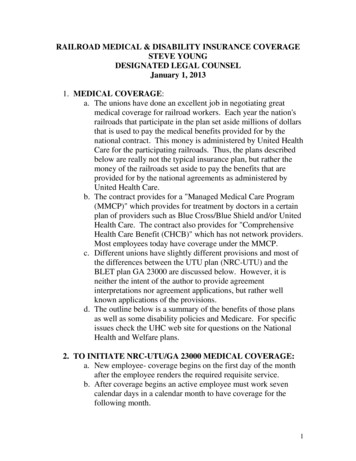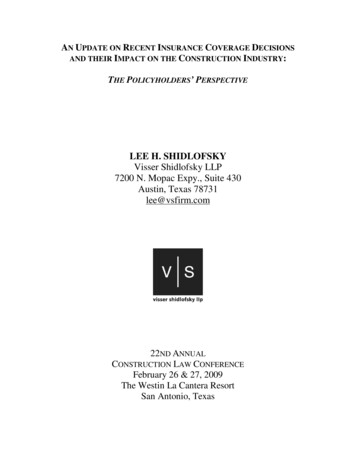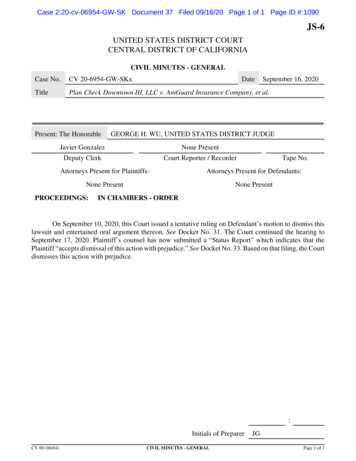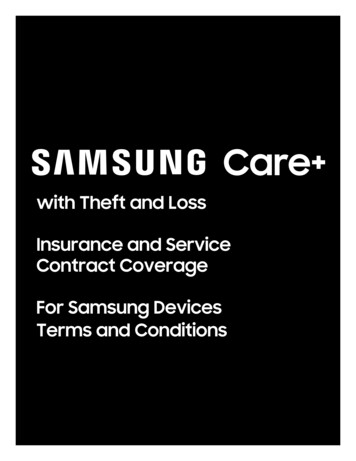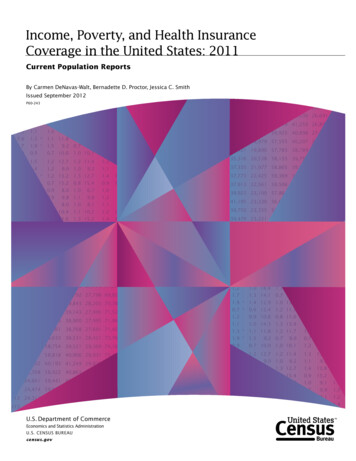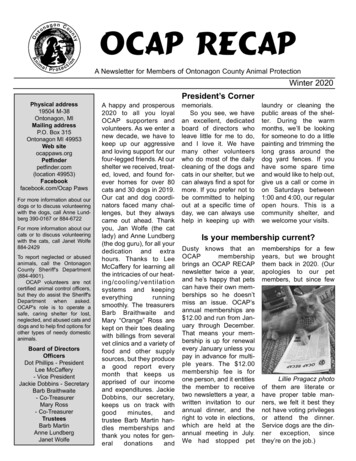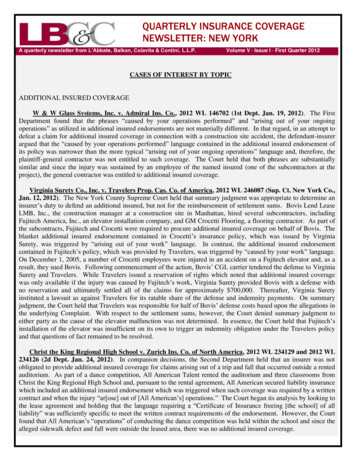
Transcription
QUARTERLY INSURANCE COVERAGENEWSLETTER: NEW YORKA quarterly newsletter from L’Abbate, Balkan, Colavita & Contini, L.L.P.Volume V · Issue I · First Quarter 2012CASES OF INTEREST BY TOPICADDITIONAL INSURED COVERAGEW & W Glass Systems, Inc. v. Admiral Ins. Co., 2012 WL 146702 (1st Dept. Jan. 19, 2012). The FirstDepartment found that the phrases “caused by your operations performed” and “arising out of your ongoingoperations” as utilized in additional insured endorsements are not materially different. In that regard, in an attempt todefeat a claim for additional insured coverage in connection with a construction site accident, the defendant-insurerargued that the “caused by your operations performed” language contained in the additional insured endorsement ofits policy was narrower than the more typical “arising out of your ongoing operations” language and, therefore, theplaintiff-general contractor was not entitled to such coverage. The Court held that both phrases are substantiallysimilar and since the injury was sustained by an employee of the named insured (one of the subcontractors at theproject), the general contractor was entitled to additional insured coverage.Virginia Surety Co., Inc. v. Travelers Prop. Cas. Co. of America, 2012 WL 246087 (Sup. Ct. New York Co.,Jan. 12, 2012). The New York County Supreme Court held that summary judgment was appropriate to determine aninsurer‟s duty to defend an additional insured, but not for the reimbursement of settlement sums. Bovis Lend LeaseLMB, Inc., the construction manager at a construction site in Manhattan, hired several subcontractors, includingFujitech America, Inc., an elevator installation company, and GM Crocetti Flooring, a flooring contractor. As part ofthe subcontracts, Fujitech and Crocetti were required to procure additional insured coverage on behalf of Bovis. Theblanket additional insured endorsement contained in Crocetti‟s insurance policy, which was issued by VirginiaSurety, was triggered by “arising out of your work” language. In contrast, the additional insured endorsementcontained in Fujitech‟s policy, which was provided by Travelers, was triggered by “caused by your work” language.On December 1, 2005, a number of Crocetti employees were injured in an accident on a Fujitech elevator and, as aresult, they sued Bovis. Following commencement of the action, Bovis‟ CGL carrier tendered the defense to VirginiaSurety and Travelers. While Travelers issued a reservation of rights which noted that additional insured coveragewas only available if the injury was caused by Fujitech‟s work, Virginia Surety provided Bovis with a defense withno reservation and ultimately settled all of the claims for approximately 700,000. Thereafter, Virginia Suretyinstituted a lawsuit as against Travelers for its ratable share of the defense and indemnity payments. On summaryjudgment, the Court held that Travelers was responsible for half of Bovis‟ defense costs based upon the allegations inthe underlying Complaint. With respect to the settlement sums, however, the Court denied summary judgment toeither party as the cause of the elevator malfunction was not determined. In essence, the Court held that Fujitech‟sinstallation of the elevator was insufficient on its own to trigger an indemnity obligation under the Travelers policyand that questions of fact remained to be resolved.Christ the King Regional High School v. Zurich Ins. Co. of North America, 2012 WL 234129 and 2012 WL234126 (2d Dept. Jan. 24, 2012). In companion decisions, the Second Department held that an insurer was notobligated to provide additional insured coverage for claims arising out of a trip and fall that occurred outside a rentedauditorium. As part of a dance competition, All American Talent rented the auditorium and three classrooms fromChrist the King Regional High School and, pursuant to the rental agreement, All American secured liability insurancewhich included an additional insured endorsement which was triggered when such coverage was required by a writtencontract and when the injury “ar[ose] out of [All American‟s] operations.” The Court began its analysis by looking tothe lease agreement and holding that the language requiring a “Certificate of Insurance freeing [the school] of allliability” was sufficiently specific to meet the written contract requirements of the endorsement. However, the Courtfound that All American‟s “operations” of conducting the dance competition was held within the school and since thealleged sidewalk defect and fall were outside the leased area, there was no additional insured coverage.
TRIGGER OF COVERAGEHunt v. Ciminelli-Cowper Co., Inc., 2012 WL 896218 (4th Dept. Mar. 16, 2012). The Fourth Departmentheld that an agreement between the project owner and contractor was an “insured contract,” within the meaning of the“Supplementary Payments” section of the contractor‟s policy and allowed an indemnitee‟s direct action to continue.Ciminelli-Cowper Co., Inc. was the construction manager at a work site owned by Jamestown Community College.In turn, JCC contracted with prime contractor Pettit & Pettit, which was required by contract to procure insurancecoverage naming JCC and Ciminelli as additional insureds. However, Pettit never obtained such coverage.Subsequently, one of the workers at the construction site was injured and commenced a lawsuit against Ciminelli.Ciminelli then instituted a third-party action seeking a declaration, inter alia, that Pettit‟s insurer, Merchants MutualInsurance Company, was obligated to provide a defense. Although Ciminelli was not an additional insured underPettit‟s policy, the “Supplementary Payments” section required Merchants to provide a defense if an indemnitee ofthe insured is also named as a party to the suit if certain conditions were met. These conditions included: “The „suit‟against the indemnitee seeks damages for which the insured has assumed liability of the indemnitee in a contract oragreement that is an „insured contract‟”; “[the] insurance applies to such liability assumed by the insured”; and “[t]heobligation to defend, or the cost of the defense of, the indemnitee, has also been assumed by the insured in the same„insured contract ‟” The Fourth Department stated that although the contract between JCC and Pettit constituted an“insured contract,” Ciminelli‟s coverage could not be determined as questions of fact needed to be resolved in orderto determine if all of the conditions of the “Supplementary Payments” section had been met.LATE NOTICEKonig v. Hermitage Ins. Co., 2012 WL 717871 (2 Dept. Mar. 6, 2012). The Second Department found thatwhen an injured party fails to exercise his or her independent right to notify a tortfeasor‟s insurer of a claim, a latenotice declination of coverage will be effective as against the injured party even though he or she does not receive acopy of the same. Shindla Koning was injured on August 6, 2008, when she slipped and fell on an exterior staircaseof a building owned by 5324 New Utrecht Realty, Inc. Harleysville Insurance Company provided insurance coverageto New Utrecht for the property in question and its policy required prompt notice of any occurrence or lawsuit. Theunderlying lawsuit was instituted on October 1, 2008 and after not responding to the complaint, Koning moved forleave to enter a default judgment as against New Utrecht in January 2009. On February 10, 2009, New Utrech‟sinsurance agent faxed a copy of the default judgment motion to Harleysville. In response, on February 26, 2009,Harleysville disclaimed coverage based on late notice of the accident and lawsuit. Pursuant to Insurance Law § 3420,Konig later instituted a direct action against Harleysville seeking to recover the amount of the ultimately unsatisfiedjudgment. However, the Second Department found that because Konig did not provide notice to Harleysville, thedeclination was effective against her as well.TIMELY DISCLAIMERQuality Building Contractor, Inc. v. Delos Ins. Co., 2012 WL 762891 (Sup. Ct. New York Co., Mar. 8,2012). The New York County Supreme Court found that an insurer‟s late notice disclaimer of coverage wasineffective as a matter of law because the insurer delayed in notifying its insured of the same due to the fact that itwas conducting an investigation into other possible reasons to disclaim. In that regard, the Court found that SiriusAmerica Insurance Company had sufficient information to issue a late notice disclaimer on February 7, 2007, but didnot issue the same until March 21, 2007. Sirius claimed that the delay was due to its need to investigate otherpotential coverage defenses. In finding that Sirius‟ disclaimer was ineffective as a matter of law, the Court stated:“Although the timeliness of such a disclaimer generally presents a question of fact, where the basis for the disclaimerwas, or should have been, readily apparent before the onset of the delay, any explanation by the insurer for its delaywill be insufficient as a matter of law.” In rendering its decision, the Court relied on the First Department‟s recentholding in George Campbell Painting v. Nat’l Union Fire Ins. Co. of Pittsburgh, PA, 2012 WL 118461 (1st Dept. Jan17, 2012)(addressed below).2
George Campbell Painting v. Nat’l Union Fire Insurance Co. of Pittsburgh, PA, 2012 WL 118461 (1st Dept.Jan. 17, 2012). The First Department found that once an insurer has identified a basis for disclaiming coverage onlate notice grounds, it may not delay in notifying the insured in order to conduct an investigation surrounding otherpossible coverage defenses. In that regard, it was found that National Union had sufficient information to disclaimcoverage on late notice grounds as of January 19, 2006, but it did not issue the disclaimer until May 17, 2006.National Union relied on DiGuglielmo v. Travelers Prop. Cas., 6 A.D. 3d 344 (1st Dept. 2004), which indicated thatan insurer‟s investigation as to alternative grounds was a reasonable excuse for delay. In response, the Courtexplicitly overruled DiGuglielmo and held that the plain language of Insurance Law § 3420(d) declares that aninsurer must notify its insured of its disclaimer “as soon as is reasonably possible.”RESCISSION/REFORMATIONThe United States Life Ins. Co. in the City of New York v. Blumenfeld, 92 A.D.3d 487, 938 N.Y.S.2d 84 (1stDept. 2012). The First Department held that an insurer‟s acceptance of premiums constituted ratification of thepolicy and waiver of its right to rescind. On April 25, 2006, the plaintiff-insurer issued a 5 million life insurancepolicy to the defendant-insured. Thereafter, in March 2007, the insurer received an investigative report revealing thatthe insured allegedly misrepresented information such as net worth and yearly income on her application. Afterobtaining this information, the insurer retained and processed the insured‟s premium payments. Nevertheless, theinsurer commenced a declaratory judgment action in April 2008 seeking to rescind the policy. The First Departmentfound that “[a]n insurer‟s failure to rescind a policy promptly after obtaining sufficient knowledge of allegedmisrepresentations by an insured constitutes a ratification of the policy,” and that “an insurer that accepts premiumsafter learning of facts that it believes entitles it to rescind the policy has waived its right.” The First Departmentwent on to hold that “an insurer‟s attempt to reserve its rights while accepting premiums is unenforceable for a lack ofmutuality” noting that “[t]his rule applies even where the insurer claims it accepted premiums after commencing arescission action to „protect‟ the insured pending a determination of the action.”Magie v. Preferred Mutual Ins. Co., 2012 WL 224896 (3d Dept. Jan. 26, 2012). The Third Department heldthat an insurer could not void a homeowner‟s insurance policy on the basis of fraud because the insurer failed todemonstrate scienter. James Magie had a homeowner‟s insurance policy with Preferred Mutual Insurance Company.In August 2005, Magie‟s house was destroyed in a fire, and he subsequently notified Preferred Mutual of the loss.Preferred Mutual made two partial advance payments and, after a considerable delay, paid the outstanding mortgagebalance. However, in March 2006, Preferred Mutual informed Magie that it considered the policy void based on itsconclusion that he had misrepresented material facts and engaged in fraudulent conduct regarding, inter alia, thevalue of his personal property. The Court stated that “[a] policy may be voided if the insured willfully andfraudulently placed in the proofs of loss a statement of property lost which the insured did not possess, or has placed afalse and fraudulent value upon the articles which the insured did own.” However, “[i]ncorrect information is notnecessarily tantamount to fraud or material misrepresentation as the insurer must tender proof of intent to defraud—anecessary element to the defense.” In reviewing the evidence presented at trial, the Third Department found thatPreferred Mutual simply did not compel the conclusion that Magie intended to defraud it.REINSURANCEU.S. Fid. & Guar. Co. v. American Re- Insurance Co., 2012 WL 178229 (1st Dept. Jan. 24, 2012). The FirstDepartment found that reinsurer American Re-Insurance Co. was liable to pay its insurer over 420 million inconnection with asbestos claims dating as far back as the mid-20th century. United States Fidelity and GuaranteeCompany was the original insurer to Western Asbestos in the 1950s and 1960s. Western Asbestos was taken over byWestern MacArthur in 1967. After a protracted litigation concerning various bodily injury claims arising fromasbestos exposure, Western MacArthur entered into a mass settlement and filed for bankruptcy protection. U.S.Fidelity, Western MacArthur‟s insurer, paid its share of the settlement and submitted a reinsurance claim to AmericanRe. American Re denied the claim and sought a declaratory judgment. In essence, American Re argued that U.S.Fidelity had neglected to assert various defenses, including that Western MacArthur‟s retention should have beenhigher than demanded, and that the settlement impermissibly included bad faith claims as designated by theBankruptcy Court. The Court held that the “Follow the Fortunes” doctrine applied to preclude all of American Re‟sarguments. It explained that the Follow the Fortunes doctrine, which is uniquely applicable in the context of3
reinsurance, prevents a reinsurer from asserting underlying defenses to liability. The Court proceeded to hold that itwas not bound by findings made by the Bankruptcy Court in connection with the question of whether the settlementincluded payment for bad faith claims because the issue was never “actually litigated.”INSURANCE AGENTS OR BROKERSSawyer v. Rutecki, 92 A.D.3d 1237, 937 N.Y.S.2d 811 (4th Dept. 2012). The Fourth Department held that aninsurance agent did not have a continuing duty to advise, guide, or direct owners to obtain additional coveragefollowing the cancellation of the procured coverage. The Fourth Department reasoned that because the insuranceagent did not receive any compensation from the insured over and above the commissions received for the policyprocured, owners did not use agent as their exclusive agent, and one of the owners retained final decision-makingauthority over what coverage to obtain, a special relationship did not exist carrying such an enhanced duty.AUTOOcean Gardens Nursing Facility, Inc. v. Travelers Cos., Inc., 2012 WL 149469 (2d Dept. Jan. 17, 2012).The Second Department found that the trial court was premature in granting summary judgment in favor of theinsurer, where the insured‟s employee caused damage while using a vehicle which was not insured under aCommercial Auto policy. The Court reasoned that since the insured‟s liability to the underlying plaintiff had not yetbeen determined, the trial court should not have ruled on the issue of whether the loss was to be covered. In addition,the Court rebuffed the insurer‟s argument that summary judgment should be affirmed because the insured providedlate notice. Since the insured had raised an issue of fact as to whether its belief in non-liability was a reasonableexcuse for the delay, an issue of fact remained that precluded the grant of summary judgment.MISCELLANEOUSGreenhomes America, LLC v. Farm Family Casualty Ins. Co., 91 A.D.3d 1352, 936 N.Y.S.2d 829 (4thDept. 2012). The Fourth Department held that an “anti-transfer” clause in a liability policy prohibited the insuredfrom transferring its rights under policy to its successor. The insured, Greenhomes America, LLC, merged withHughesCo, Inc., which had a liability policy issued by defendant Farm Family Casualty Insurance Company with ananti-transfer clause. In November 2005, there was a fire in a residence allegedly caused by Greenhomes andHughesCo, and the homeowners‟ insurer sought by way of subrogation reimbursement for the losses incurred as aresult of the alleged negligence. Greenhomes then sought a declaration that Farm Family was obligated to defend andindemnify it against the subrogation action. In finding that the anti-transfer clause in HughesCo‟s liability policyprohibited transferring rights under the policy to Greenhomes, the Fourth Department stated, “As a general matter,New York follows the majority rule that [an anti-transfer clause] is valid with respect to transfers that were madeprior to, but not after, the loss has occurred The idea behind the majority rule is that, once the insured-against losshas occurred, the policy holder essentially is transferring a cause of action [or its liability] rather than a particular riskprofile.”Persuad v. Bovis Lend Lease, Inc., 2012 WL 1020680 (2d Dept. Mar. 27, 2012). The Second Departmentheld that a sub-subcontractor was not contractually obligated to procure insurance for the subcontractor or the generalcontractor on a construction project. Gessin Electrical Contractors, Inc. entered into a subcontract with BuildingTechnologies Group, Inc. and while working at the construction site, one of Gessin‟s employees was injured. Theinjured employee commenced a lawsuit against BTG and Bovis Lend Lease, Inc. BTG and Bovis then commenced athird-party action against Gessin, inter alia, for contractual indemnification and to recover damages for breach ofcontract for failure to procure insurance on their behalf. In holding that Gessin was not required to procure insuranceon behalf of BTG and Bovis, the Second Department found that these causes of action were based upon a promisefound in the prime agreement between BTG and Bovis, to which Gessin was not a signatory. The Court elaboratedthat “[d]espite the fact that the construction subcontract signed by Gessin incorporated the main agreement byreference, under New York law, incorporation clauses in a construction subcontract, incorporating the prime contractclauses by reference into a subcontract, bind a subcontractor only as to prime contract provisions relating to thescope, quality, character and manner of the work to be performed by the subcontractor.” Accordingly, the Second4
Department held that the provisions in the prime agreement relating to contractual indemnification for an employee‟sinjuries and insurance procurement were not incorporated by reference into the subcontract between BTG and Gessin.LBC&C’s INSURANCE INDUSTRY PRACTICE GROUPLBC&C has extensive knowledge and experience in the insurance industry, and the wide array of services which itprovides to the insurance community is a foundation of the Firm‟s practice. LBC&C is dedicated to achieving thegoals of its clients in a professional, cost-effective and timely manner. The Firm‟s reputation for meaningfulanalysis, tough advocacy and creative solutions serves clients well for the regulatory and legal challenges which theyface in the ever-changing national landscape of the insurance industry. Insurance companies rely upon LB
Virginia Surety Co., Inc. v. Travelers Prop. Cas. Co. of America, 2012 WL 246087 (Sup. Ct. New York Co., Jan. 12, 2012). The New York County Supreme Court held that summary judgment was appropriate to determine an insurer‟s duty to defend an additional insured, but not f


